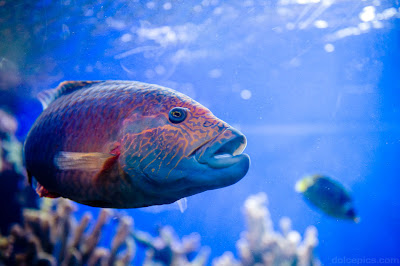10 Amazing New Animal Species Discovered In 2012
You’d think that after living alongside them for millions of years, we’d know just about every animal that roams the earth and its atmosphere. Thanks to limitations posed by our bodies and accessible technology, however, that’s far from true.
Recent research suggests that an astonishing 86 percent of all plants and animals on land and 91 percent of those in the seas have yet to be named and cataloged. Sadly, this revelation only underscores the importance of conservation: since human development and climate change means that many species will become extinct before they’re discovered.
Despite these seemingly insurmountable threats, scientists of all disciplines are still out in the field, working hard to create a record of each and every magnificent species our planet has to offer. As 2012 draws to a close, we thought it might be fun to spotlight some of the new creatures that took their official place in history this year. Some are big, some are small. Some are startling, while others are living works of art.
As you glance over these images, keep in mind the words of biochemist William H. Schlesinger who said, “Each species on our planet plays a role in the healthy functioning of natural ecosystems, on which humans depend.” Even though you may not have known that one or more of these species even existed, remember that your quality of life is dependent on theirs. Let that thought guide our actions in the year ahead. (Note: some of these species were first spotted in previous years, but because of the time and effort it takes to verify a new species, were only acknowledged as legitimate this year.)
1. Troyus turneri butterfly – Jamaica
Belonging to the family of skipper butterflies, the new genus and species is the first butterfly discovered in Jamaica since 1995. Scientists hope it will encourage conservation of the country’s last wilderness where it was discovered: the Cockpit Country. Measuring little more than 1 centimeter across, researchers say this tiny butterfly — named Troyus for the nearby town of Troy –underscores the need for further biodiversity research and establishing a baseline of organisms as more tropical areas suffer habitat destruction.
2. Sazima’s Tarantula – Brazil
This iridescent blue tarantula was technically discovered in 2011, but it’s listed among Arizona State University’s Top 10 New Species in 2012. Survival of tarantula species can be at risk due to loss of habitat and over-collecting for the pet trade. Although Pterinopelma sazimai is not the first blue tarantula, it is one of the most striking and may be especially vulnerable because of its limited distribution in an “ecological island” – a habitat high upon tabletop mountains which have a greater rainfall and different soils than the immediately surrounding area.
3. Coastal Skink – Australia
Discovered by researchers at Australian National University, the 6cm long Ctenotus ora, or the Coastal Plains Skink, only lives in the dunes along the Swan Coastal Plain between Dunsborough and Mandurah, south of Perth. Unfortunately, this exact area is already being developed for new residential housing, meaning that our relationship with this fascinating lizard could be quite short-lived. The species specializes in sand dunes, so it lacks the ability to move and adapt to a new habitat.
4. Lesula Monkey – Democratic Republic of Congo
Cercopithecus lomamiensis is a newly discovered species of African monkey found in central Democratic Republic of Congo. Together with the ‘honk barking’ Highland mangabeys (Lophocebus kipunji) of Tanzania, C. lomamiensis is only the second new species of monkey discovered in Africa in the past 28 years. Called “Lesula” by locals, the monkey was discovered by a team led by conservation biologist John Hart from the Lukuru Wildlife Research Foundation. While there is so far no logging or mining taking place in the region, hunting represents an immediate threat to the species’ survival, according to the researchers. “For species with restricted ranges and reliance on primary forest, such as C. lomamiensis, uncontrolled hunting can lead to catastrophic declines over a short period,” the researchers state, calling for heightened conservation efforts and hunting controls to be established.
5. Meat-Eating Sponge - California’s Monterey Bay

Chondrocladia lyra is a meat-eating sea sponge shaped like a candelabra. It was spotted living two miles below the surface of California’s Monterey Bay and features branching limbs covered in velcro-like barbed hooks that help the sponge snare crustaceans as they are swept into its branches by deep-sea currents. ”We were just amazed. No one had ever seen this animal with their own eyes before,” said Lonny Lundsten, an invertebrate biologist at the Monterey Bay Research Aquarium Institute. The team believes the harp sponge evolved this elaborate, candelabra-like structure to increase the surface area it exposes to currents so it can capture more prey.
6. Purple Yoda Worm - Mid-Atlantic Ridge between Iceland and the Azores
Yoda purpurata is the name now given by a University of Aberdeen-led team of scientists to one of three new species of deep sea acorn worms or Enteropneusts discovered around 1.5 miles below the surface of the Atlantic Ocean. A reddish-purple acorn worm with large lips either side of its head region reminded researchers of floppy-eared Star Wars character Yoda while pupurata is Latin for purple and describes its colorful hue. “Whilst they are not strictly a missing link in our own evolution they give an insight into what the lifestyle of our remote ancestors might have been like,” said Professor Monty Priede, Director of the University of Aberdeen’s Oceanlab, who led the research. ”Despite their recent discovery these animals are not rare in the deep, and now we have the technology we are finding them in abundance. The next question to be addressed is the role they play in the deep sea ecosystem.”
7. Squat Lobster - Northwest coast of Spain
A new squat lobster called Uroptychus cartesi was recently discovered in the underwater mountains off the northwest coast of Spain. Squat lobsters are more closely related to porcelain and hermit crabs than true lobsters. The new type of lobster belongs to the Chirostylidae family and is one of the mere four species that live in Europe. Three of them were discovered at the end of the 19th century and the fourth in 1976. Fourteen can be found in the Americas and more than 100 exist in the Indo-Pacific Ocean. The small orange-colored squat lobster usually lives around deep corals and gorgonians and “tends to be abundant in submarine mountains and canyons that have been subject to little fishing,” explains study co-author Enrique Macpherson, who goes on to add that gorgonians and corals are the first to disappear in trawling zones.
8. Bumblebee Gecko - Papua New Guinea
Dubbed Nactus kunan—kunan, meaning “bumblebee” in the local Nali language, the black-and-gold striped animal found on Manus Island belongs to a genus of slender-toed geckos. That means “these guys don’t have the padded, wall-climbing toes like the common house gecko or the day gecko in the car-insurance commercials,” study co-author Robert Fisher, a biologist at the U.S. Geological Survey Western Ecological Research Center in San Diego, said in a statement. It’s unknown how many of the roughly 5-inch-long (13-centimeter-long) geckos exist, or if the species is threatened, according to the study.
9. Red-Breasted Barbet – Andes Mountains
Capito fitzpatricki is a new bird species discovered by three young ornithologists who had recently graduated from Cornell. While commonly known as the Sira Barbet, the team chose the scientific name, Capito fitzpatricki, in honor of Cornell Lab of Ornithology executive director John W. Fitzpatrick, who discovered and named seven new bird species in Peru during the 1970s and ’80s. The team discovered the barbet on a ridge of mountainous cloud forest in the Cerros del Sira range in the eastern Andes.
10. Obama-fish
Five new species of colorful, freshwater fish called darters have been discovered in river drainages in eastern North America and named after four presidents and a vice president. Darters are the smallest members of the perch family, and are named after their ability to zip around, under and into rocks and sediment on the beds of clean, fast-moving waterways. Newly re-elected President Obama was one of the lucky leaders to have a darter named after him. The spangled darter — a 2-inch Tennessee native whose males have vivid orange, blue and green scales — will be Etheostoma obama from now on.



Comments
Post a Comment